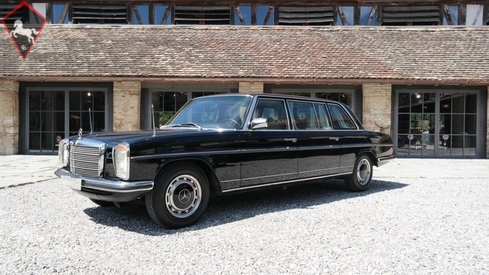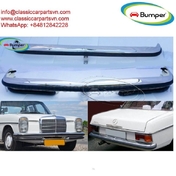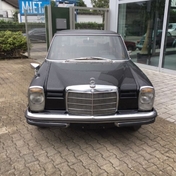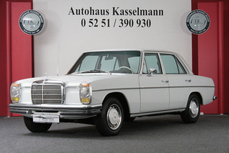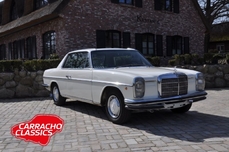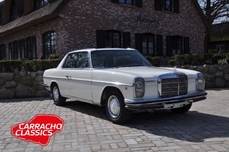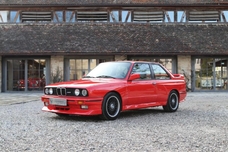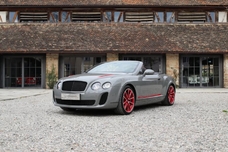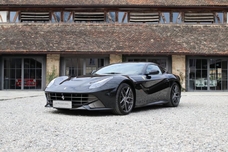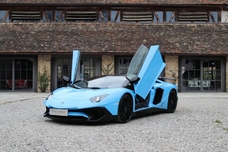Mercedes-Benz 250 w114 Pullmann Langversio 1973
General description :
Dieser wunderschöne W114 230C Automatik Langversion/Pullmann wurde 1974 von keinem geringeren wie Josip Broz Tito, dem ehemaligen Staatspräsidenten von Jugoslawien genutzt. Tito war als leidenschaftlicher Fan von Mercedes Pullmann Modellen bekannt und so reihte sich auch dieser W114 in die Reihe von seinen insgesamt 6 Mercedes Pullmann ein. Das Fahrzeug wurde wohl aber sehr selten genutzt, so weist heute der Kilometerzähler gerade mal einen Stand von 51.850 Kilometer auf. Die Staatskarosse befindet sich in sehr originalen und wunderschönen Zustand. Das gesamte Fahrzeug ist unrestauriert, wirkt jedoch absolut neuwertig. Als Sonderausstattung wurden neben gekühlten Staufächern, 6 Sitzplätzen (wobei zwei Sitze für die Beinfreiheit weggeklappt werden können), Gardinen, Klimaanlage, elektrischen Fensterhebern und edlem Wurzelholz auch hochwertige Wollvelour-Sitze bestellt. Es wurden nur sehr wenige Langversionen des W114 gebaut. Der Wagen präsentiert sich mit größtenteils wunderschönen schwarzen Originallack, einer sehr gepflegten Innenausstattung und tollen Chromteilen sowie Spaltmaßen. Die Chance nicht nur ein eindrucksvolles Fahrzeug, sondern auch ein Stück Geschichte zu erwerben.
Wir liefern dieses Fahrzeug mit neuem TÜV sowie der H-Zulassung.
This beautiful W114 230C Automatic Long Version / Pullman was used by none other than Josip Broz Tito, former President of Yugoslavia. Tito was known as a passionate fan of Mercedes Pullman models and so joined this W114 in the series of his total of 6 Mercedes Pullman. The vehicle was probably used very rarely, so today the odometer has a stand of just 51,850 kilometers. The state coach is in very original and beautiful condition. The entire vehicle is unrestored, but looks absolutely new. In addition to cooled storage compartments, 6 seats (two seats can be folded away for the legroom), curtains, air conditioning, electric windows and noble as well as high-quality wool velor seats were ordered as special equipment. Very few long versions of the W114 were built. The W114 presents itself with mostly beautiful black original paint, a very neat interior and great chrome parts and gaps. The chance to acquire not only an impressive vehicle, but also a piece of history.
We deliver this vehicle with new TÜV and the H-approval.
Zwischenverkauf und Irrtümer für dieses Angebot sind ausdrücklich vorbehalten. Ausschlaggebend sind einzig und allein die Vereinbarungen im Kaufvertrag.
1973 Mercedes-Benz 250 w114 Pullmann Langversio is listed for sale on ClassicDigest in Polling by HK-Engineering GmbH for €49000.
Car Facts
Car type : Car Make : Mercedes-Benz Model : 250 w114 Model Version : Pullmann Langversio Engine size : 0.0 Model Year : 1973 Location : Polling Vehicle Registration : Undefined
49000 €
People who viewed this Mercedes-Benz 250 w114 also viewed similar Mercedes-Benz listed at ClassicDigest
Other cars listed for sale by this dealer
About Mercedes-Benz
In the annals of automotive history, the journey of Mercedes-Benz is a tale that unfolds with the ingenuity of its founding pioneers. In the year 1886, Karl Benz crafted the Benz Patent Motorwagen, a creation that would go down in history as the world's inaugural automobile. Unbeknownst to him, this moment marked the genesis of what would evolve into the most illustrious premium car manufacturer globally. The financial underpinning of this pioneering venture, interestingly, was provided by Karl Benz's wife, Bertha Benz, demonstrating a remarkable partnership that would set the tone for Mercedes-Benz's legacy.A parallel narrative emerged not far away, as Daimler-Motoren-Gesellschaft, founded by Gottlieb Daimler and Wilhelm Maybach, entered the scene. In 1901, they unveiled their automobile under the now-famous moniker "Mercedes," meaning "godsend" in Spanish. This name was bestowed upon the car at the behest of Emil Jellinek's daughter, the distributor for Daimler-Motoren-Gesellschaft. The wheels of innovation were set in motion.
Fast forward to 1926, a pivotal year that witnessed the merger of Daimler with Benz & Cie., culminating in the birth of Daimler-Benz. The amalgamation saw the adoption of "Mercedes-Benz" as the distinguished trademark for their automobiles, fusing the legacies of two visionary entities into one.
Contrary to perceptions of conservatism, the trajectory of Daimler-Benz unfolds as a chronicle of industry firsts. From the introduction of the honeycomb radiator to the float carburetor, and the pioneering implementation of four-wheel brakes in 1924, Daimler-Benz consistently pushed the boundaries of automotive innovation. The diesel-powered Mercedes-Benz 260 D in 1936 marked the inception of diesel engines in passenger cars. The iconic Mercedes-Benz 300SL Gullwing made history as the first car with direct fuel injection, albeit the Gutbrod's tiny 2-stroke engine can claim precedence.
Safety innovations became a hallmark, with Béla Barényi's patented safety cell design in the "Ponton"-models in 1951, featuring front and rear crumple zones. The W116 450SEL 6.9 saw the introduction of the Anti-Lock Brake system (ABS), another pioneering safety feature. From the first production airbags and beyond, the legacy of "firsts" continued to be etched into the fabric of Daimler-Benz.
Over its centennial journey, Mercedes-Benz has not merely produced cars but has sculpted automotive icons. The SSKL, 710 SSK Trossi Roadster, 770K Grosser, 540K Spezial Roadster, 300SL Gullwing, w100 600 Pullman, w111 280SE 3.5 Flachkühler, w113 230SL Pagoda, w109 300 SEL 6.3, and w201 2.3-16 Cosworth stand testament to the brand's commitment to engineering excellence.
The roaring Silver Arrows, or "Silberpfeile," including the W 25, W 125, W154, W165, and W196, created a legacy of dominance on the racetrack. These machines were not merely cars; they were expressions of precision, speed, and an indomitable spirit that left their competitors in the dust.
As Mercedes-Benz marches into the future, it does so not just as an automaker but as a custodian of a legacy, a torchbearer of innovation, and a beacon of automotive excellence. The road ahead is sure to witness the continued fusion of cutting-edge technology, timeless design, and an unwavering commitment to setting new standards in the world of automobiles.
One luminary figure who left an indelible mark was Béla Barényi, often heralded as the "father of passive safety" for his pioneering work in safety engineering. His patented safety cell design, featuring front and rear crumple zones, became a hallmark of Mercedes-Benz's commitment to occupant safety, setting new standards that reverberated throughout the automotive world.
Moving through the chronicles, the collaborative genius of Wilhelm Maybach, alongside Gottlieb Daimler, laid the foundation for Daimler-Motoren-Gesellschaft. Their innovations not only birthed the first Mercedes but established a culture of relentless pursuit of technological excellence that remains integral to Mercedes-Benz's DNA.
In the post-merger era of 1926, Ferdinand Porsche emerged as a prominent figure within Mercedes-Benz. His work on the Mercedes-Benz S-Type, a supercharged race car, garnered acclaim and set the stage for a legacy that extended far beyond the marque. Porsche's impact would later extend to his eponymous company, but his influence at Mercedes-Benz during those formative years was pivotal.
As the 20th century progressed, the legendary Rudolf Uhlenhaut emerged as a key figure. Uhlenhaut, an accomplished engineer and the driving force behind the iconic Silver Arrows, played a crucial role in Mercedes-Benz's dominance in motorsports. His engineering prowess and attention to detail were instrumental in creating some of the most formidable racing cars of the era.
In the latter half of the century, figures like Bruno Sacco, the head of design at Mercedes-Benz from 1975 to 1999, left an indelible imprint on the brand's aesthetic identity. Sacco's design philosophy, characterized by clean lines and timeless elegance, shaped iconic models like the W126 S-Class and the W201 190E, solidifying Mercedes-Benz's reputation for luxury and sophistication.
The narrative would be incomplete without acknowledging the contributions of engineers like Hans Scherenberg, whose leadership in the 1970s ushered in a new era of technological innovation at Mercedes-Benz. Scherenberg's tenure saw the development of groundbreaking technologies, including the Anti-Lock Brake system (ABS) and the introduction of airbags in production cars.
